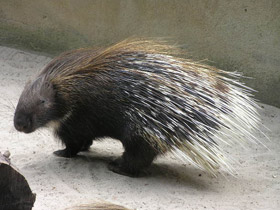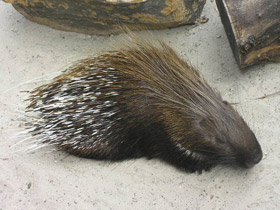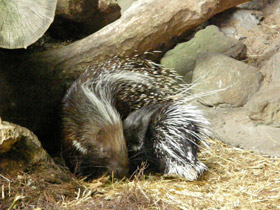The Indian crested porcupine(Hystrix indica)
Indian crested porcupine видео
The Indian crested porcupine (Hystrix indica) is a hystricomorph rodent species native to southern Asia and the Middle East. It is listed as Least Concern on the IUCN Red List. It belongs to the Old World porcupine family, Hystricidae.
Distinguishing features
It is a very large rodent: its body length varies from 70 to 90 cm. The underside of the body, limbs, head, neck and shoulders of the porcupine are covered with coarse bristles, and from the middle of the head to the shoulders there is a gradually increasing backward row of protruding, long and hard bristles. Its anterior part of the body is covered with longer flat bristles, while the posterior part, on the back and sides, is covered with thick spindle-shaped needles, from 30 to 300 mm long. Among these needles, long and bendable, are abundantly scattered shorter and thicker, unbendable needles, and at the end of the tail is a small bundle of hollow needles cut off at the ends, which the rodent in a state of irritation shakes like rattles, producing a characteristic crackle.
Habitat and lifestyle
Hystrix indica is distributed in the arid territories of Asia Minor and Central Asia, Western Arabia, Transcaucasia, Southern Kazakhstan, Hindustan, Tibet, Sri Lanka. This rodent inhabits foothills and low mountains at altitudes up to 2400 m above sea level, but is also found on plains, where it adheres to the slopes of river valleys. It leads a solitary way of life and settles in burrows dug by it, which have rather complicated structure with total length of passages up to 20 m, as well as in caves, cavities among rocks and stones, in scour holes of loess cliffs. In summer the porcupine is active only in the dark, in winter it can come out of the shelter during the daytime, sometimes travelling considerable distances in search of food.
What Hystrix indica feeds on
Hystrix indica feeds on fruits of wild and cultivated plants, greens, roots, bulbs, rhizomes and bark. Unlike most other desert rodents, the Indian porcupine needs a watering hole. In early spring, it feeds mainly on rhizomes and bulbs and emerging young shoots. With the appearance of the first fruits (mulberries, uruk), this rodent visits gardens and eats large quantities of fallen fruits. In summer it raids corn and sorghum fields, as well as melons, where it especially damages pumpkin and melon fruits; in autumn it eats large quantities of wild and cultivated grapes and other fruits. The porcupine does not hibernate, but in winter its activity decreases considerably, at which time it nibbles the bark of trees and shrubs and feeds on underground parts of herbaceous plants.
Distribution and habitat
Indian crested porcupines are found throughout southwest and central Asia, including Afghanistan, Armenia, Azerbaijan, China, Georgia, India, Iran, Iraq, Israel, Jordan, Kazakhstan, Kyrgyzstan, Lebanon, Nepal, Pakistan, Saudi Arabia, Sri Lanka, Turkey, Turkmenistan, and Yemen. Due to their flexible environmental tolerances, Indian crested porcupines occupy a broad range of habitats. They prefer rocky hillsides, but are also common in tropical and temperate shrublands, grasslands, forests, plantations, and gardens. Their range seems to be limited by seasonal densities of forage and the availability of suitable substrates for digging burrows. More specifically, the northern range of the Indian crested porcupine is limited by minimum summer night duration: they do not occur above latitudes where minimum night duration is less than 7 hours, presumably because of the amount of foraging time required to meet their dietary needs.
In 2018, a porcupine was spotted at Wadi Wurayah in the United Arab Emirates. In 2019, it was spotted in the Russian republic of Dagestan.
Diet
Indian crested porcupines have a very broad and mostly herbivorous diet. They consume a variety of natural and agricultural plant material, including roots, bulbs, fruits, grains, drupe and tubers, along with insects and small vertebrates. Because they are cecal digesters, they are able to exploit low quality forage. They have also been known to chew on bones to acquire minerals, such as calcium, that aid in quill growth. Their capability to form substantial fat reserves is a useful adaptation for living in seasonally fluctuating habitats.
These porcupines can act as substantial habitat modifiers when excavating for tubers. They are also considered serious agricultural pests in many parts of their range due to their taste for agricultural crops. For these reasons, they are often regarded as a nuisance.
Behaviour
Like other Old World porcupines, the Indian crested porcupine is nocturnal. Both adults and weaned juveniles spend an average of 7 hours foraging every night. They tend to avoid moonlight in the winter months, which could be a strategy to evade predation. However, during summer months they do not avoid moonlight (likely because there are less dark hours during which to forage), but instead tend to stay closer to their dens. During the day, they remain in their dens, but throughout the winter, they occasionally emerge from their dens during daylight hours to bask in the sun.
The Indian crested porcupine is semifossorial. They live in natural caves or in excavated burrows. Because they do not climb or jump well, they spend most of their lives on or under the ground. However, they are good swimmers.
Predators of the Indian crested porcupine include large cats, caracals, wolves, striped hyenas, Asian wild dogs, Saltwater crocodiles and humans. When excited or scared, a porcupine stands its quills up to appear larger. It can also rattle the hollow quills at the base of its tail, stomp its feet, growl, grunt, or charge backward into the threat.
Reproduction
Indian crested porcupines mate in February and March. Gestation lasts an average of 240 days. A female gives birth to one brood of two to four offspring per year. Young are born with open eyes and are covered in short, soft quills that harden within a few hours after birth. Young are fully weaned 13–19 weeks after birth, but remain in the den with parents and siblings until sexual maturity around 2 years of age. It has been reported that the Indian crested porcupine is usually monogamous and mates every night throughout its life, not only for reproduction, but also to maintain and strengthen the pair bond, the relationship between the male and female partners. Previously, this had only been found in humans, Bonobos, and some dolphins.
Conservation
Due to its adaptability to a wide range of habitats and food types, the Indian crested porcupine is listed by the IUCN Red List as Least Concern as of 2008. Populations are stable and not severely fragmented, and while population status varies across its range, in many places it is common enough to be considered a pest. However, as a result of urbanization, infrastructure development, and pesticide use, suitable porcupine habitat is currently declining.
The Indian crested porcupine is protected under the India Schedule IV of the Indian Wildlife Protection Act of 1972, amended up to 2002. Nonetheless, because it is destructive to gardens and agricultural crops, it is widely hunted. It is traded for consumption and medicinal use.













































